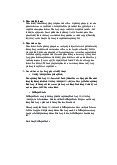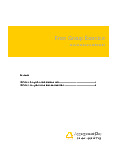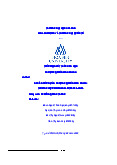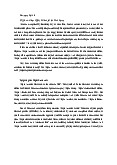



Preview text:
Free Group Exercise
Candidate Instructions Booklet
This exercise has been designed to simulate the type of group exercises which are
typically used by employers. We recommend you work through this group exercise with
at least three other people in order to create a realistic exercise preview. In this group
exercise each candidate is deliberately given the same instructions. Sometimes however
candidates will be assigned a role which they will have to adopt during the exercise.
After you have completed this exercise, you can review our Candidate Guidance Booklet
to see what behaviours assessors would typically look for in this exercise, what sort of
ideas might get suggested during the exercise, and tips for how you should conduct
yourself during a group exercise.
The exercise will begin on the next page.
Introduction
This exercise has been developed to predict your behaviour in the workplace and assess your
effectiveness at working within a team. This group exercise will require you to address a number of
issues and provide practical solutions as a group. Exercise Scenario
Silverman & Briar (S&B) is a regional banking firm headquartered in the north east of England. Its
services include investment, merchant, retail and private banking; with the bulk of its revenue
generated by its retail banking service. S&B’s current marketing strategy and unique selling point is
to cater exclusively to customers in the region, cementing its position as the traditional “local bank”
in the area. However due to increased competition from the big names in international banking, S&B
is losing its grip on the north east, threatening its position as the chosen bank in these communities.
You have recently joined S&B as a graduate management trainee. As part of your development, you
have been asked to participate in a meeting to address current and strategic issues alongside senior
management. In preparation for this meeting, you and a number of your colleagues are attending a
committee meeting to discuss the way forward and to provide practical recommendations. You will
be discussing each issue and will have to come to a mutual agreement on the most suitable course of action for each case.
The group’s recommendations must be as specific as possible, outlining exactly what actions need to
happen next. It will help to imagine yourself in the scenario and think about what actions you would
take if faced with these issues for real in the workplace.
It is important that the group reaches a majority consensus on each issue. Please note that you or
the group may have to explain to other stakeholders the recommendations made, and you should be
prepared to justify the decisions the group agrees upon.
The group will have 45 minutes for this exercise.
You may share this document with others as long Page 2
as you credit AssessmentDay.co.uk with a website
link but you can’t change this document in any www.assessmentday.co.uk
way or use its contents commercially.
Document last updated 05-07-2013 Management Issues
1. Due to local economic difficulties facing north east England, this year’s projections predict a
significant drop in profits from S&B’s flagship retail banking service. The economy of the
north east for many years has relied on heavy industry, particularly ship building,
petrochemical refining and chemical production. Current economic pressures on these
industries could lead to factory closures, causing a significant exodus of employees in the
region. Due to S&B’s presence in the region, a migration of customers away from the north
east will inevitably lead to loss of revenue, however at a board meeting a potential remedy
was identified. Introducing a new online services division may allow S&B to continue
providing banking services to customers regardless of their geographical position. This
solution was met with mixed results by the board, with traditionalists favouring the
conventional bricks and mortar style and modernists wanting to catch up with big high-
street banks. Senior management has asked for the input of junior management regarding
the implementation of this service and its potential implications.
As a group, identify the pros and cons of implementing an online banking service at S&B and decide on a way forward.
2. S&B’s investment banking service has shown steady performance since its inception,
generating moderate profits but without significant growth. However following the recent
liquidation of a local competitor specialising in investment banking services, a potential gap
in the market has appeared. With S&B’s large presence in the area, this presents an
opportunity for a much-needed expansion of its investment banking division. However due
to the failure and subsequent liquidation of S&B’s local competitor, the competitor’s clients
have become sceptical of working with local banks, and may be considering moving their
custom to larger, international firms. In order to take advantage of this potential
opportunity, and avoid losing this market segment to other competitors, your manager has
asked for your input into how best to win over the competitor’s previous clients.
What recommendations would the group make to persuade the competitor’s previous
investment banking clients to migrate their custom to S&B?
3. During a brainstorming session regarding offering new services and generating new
products, a number of executives have decided to offer Islamic banking services. Sharia law
prohibits the payment of interest for loans, known as Riba, or usury, excluding many
Muslims from traditional UK banking services. An Islamic style mortgage would require the
bank to purchase a house from the seller, and resell the house to the customer of the
mortgage at a profit. The executives also made clear during the brainstorming session that
any new Islamic banking services and Islamic style mortgages would be available to non- Muslim customers as well.
Senior executives are keen to implement this new service, so are looking to junior members
for solutions to the following obstacles which were identified.
You may share this document with others as long Page 3
as you credit AssessmentDay.co.uk with a website
link but you can’t change this document in any www.assessmentday.co.uk
way or use its contents commercially.
Document last updated 05-07-2013
First is that introducing new and exotic products may change perceptions of S&B from a
traditional local bank, to a more unconventional and progressive organisation; a huge
change in branding strategy. Such a move could make the more “set in their ways”
traditionalist customers sceptical of the bank, and possibly lose their custom to other banks
catering to the simpler local bank strategy.
Secondly from an organisational perspective, S&B has no experience with Islamic finance
and would require the work of outside consultants to introduce the service and manage the
change. Outside consultants can be expensive and change initiatives as radical as this are
known to have little chance of working and high chances of being met by resistance from the firm’s employees.
The third and final issue is that the north east of England has a relatively small Muslim
population. Religious demographic surveys indicate that over 70% of the population of north
east England reported their religion as Christianity and 12% indicated they had no religious affiliation.
As a group, discuss the potential implications of introducing this new service, and provide
practical steps to ensure that this service is implemented successfully.
4. S&B’s local competitor, Berkley Stone Partners (BSP) is a spinout company which initially
formed part of S&B before its management took independent control through a
management buyout. The private equity company that financed the buyout have since made
an exit, but BSP’s profitability has steadily dropped, and its reputation has faltered. BSP
through poor management practices and bear-market conditions has run into a significant
amount of toxic debt and may not have the capacity to recover on its own. Toxic debt in this
sense relates to loans which are at risk of not being paid back, and are made against an asset
which wouldn’t make much money if sold. BSP has shown significant interest in re-joining
S&B, hoping to avoid large layoffs and potential bankruptcy.
On one hand this would seem like a mutually beneficial arrangement; BSP was previously
part of S&B and shares a similar organisational culture and values, increasing the likeliness of
a successful merger. Similarly, due to BSP’s financial difficulties, the firm could be purchased
relatively cheaply, gaining access to other areas in the north east which are not currently S&B territories.
However S&B would become ultimately responsible for BSP’s falling profits, requiring
significant work and investment to transform the company to a more functional, effective
arm of the organisation. It is also possible that should transforming the company fail, and
the firm continue to function poorly, BSP’s toxic debt could drag down profits at S&B,
putting S&B in a precarious position.
Identify the factors which could influence both success and failure in this merger, and as a
group decide if the merger should go ahead.
-- End of Exercise Documentation --
You may share this document with others as long Page 4
as you credit AssessmentDay.co.uk with a website
link but you can’t change this document in any www.assessmentday.co.uk
way or use its contents commercially.
Document last updated 05-07-2013



